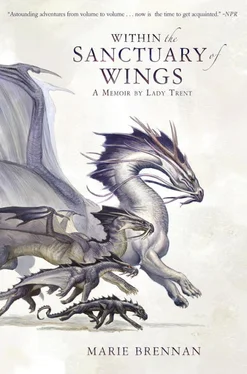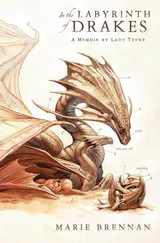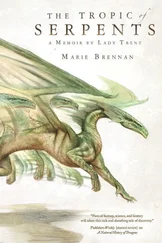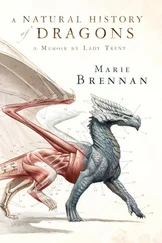“I found the body of a dragon,” he said. “Or rather, part of one. It was incomplete, but there was enough for me to be certain that I did not recognize its breed.”
“Are you a natural historian, that you are very familiar with different kinds of dragons?”
Mr. Thu shook his head. “No, Lady Trent. But I have been in the mountains before; I know the dragons that are found there. This was not of any kind I know.”
Tom frowned. When questioning someone, it is often effective to have one interrogator behave in a skeptical fashion, while the other is more credulous; but I fear both Tom and I took on the role of skeptic at the start of that evening. He said, “It might not be a mountain breed.”
“Perhaps. But then what was it doing there?”
“Where is ‘there’?” I asked. “Which mountains?”
“The Mrtyahaima.”
His answer startled me into silence. The Mrtyahaima Mountains are, of course, one of the great geological features of the Dajin continent. Comprising a number of interlocking ranges, they dwarf what we call “mountains” in many other parts of the world. If the measurements of surveyors are accurate, the fifteen tallest peaks in existence are all found in that region, each one more than eight thousand meters high.
Long famous to the inhabitants of Dajin, they had become more well known in Anthiope since the advent of mountaineering as an athletic activity. Our early climbers were content to test themselves against the lesser peaks of the Vystrani Mountains or the Netsjas in Bulskevo, but as more and more of those were conquered, the ambitious turned their attentions to Dajin and the Mrtyahaima. No one even knew whether it was possible to climb an eight-thousand-meter peak: could human beings survive at such altitude? Nowadays we believe they can, but no one has yet succeeded in reaching a summit that high.
The Mrtyahaima were of interest to us for other reasons as well. The various ranges grouped under that name, running as they do from near the northern coast well into the interior, almost bisect the continent. To the east lies Vidwatha; to the west, Yelang. And Scirland, of course, had various colonial possessions in Vidwatha—which meant the two nations had spent years glaring at one another across the nearly impassable barrier of the mountains.
I racked my memory for what I knew of Mrtyahaiman draconic breeds. It was disappointingly little: the region was so remote, what reports we had largely came from non-scholarly sources. They described everything from small, cat-like dragons supposedly kept as pets by the peoples of the high valleys to demonic beasts composed entirely of ice. “Describe to me what you found. It was a fresh kill?”
Mr. Thu shook his head. “No. I don’t know how long it had been dead, but it must have been at least a year. Or longer.”
Could bones preserve naturally under the geologic conditions of that range? I had no idea. “With only a skeleton to study, how can you be sure it was a strange breed?”
“It was not a skeleton,” Mr. Thu said. “No bones at all. Meat and hide.”
We ground to a halt for a terribly long time on this point, for Tom and I were sure that something must be going awry in the translation. But Suhail, questioning Mr. Thu in Yelangese, suddenly uttered an oath. In Scirling, he said, “Like a bog body!”
“What?” I asked, even more confused than before.
He hastened to explain. In Uaine and some parts of Heuvaar, ancient societies made a practice of sacrificing people by strangling them and sinking their bodies into peat bogs. The chemical composition of the water naturally pickles the flesh, preserving the soft tissues that would ordinarily decay—but it dissolves the bones, leaching away the calcium until what remains is, in Suhail’s words, “a slimy, boneless sack.”
A similar thing had happened to the specimen Thu Phim-lat found, but for entirely different reasons. The bones of the dead creature had long since disintegrated, as is common among draconic species. But the carcass, high in the Mrtyahaima peaks, had frozen after death, which kept the flesh from rotting as it ordinarily would. “They’ve found mammoths in the permafrost of northern Siaure,” Tom pointed out. “This sounds much the same.”
“Half mammoth, half bog body,” I murmured. The prospect was enchanting. Paleontologists, scientists who study extinct organisms, are accustomed to working from nothing more than skeletons. In my field of research, where we are rarely so lucky as to have skeletons to study, the evolution of draconic species is a near-total mystery. We had some theories, but most of them had fallen to pieces with the discovery of developmental lability. Facts were very thin on the ground, and preserved tissue was nothing short of a miracle.
But when I asked Mr. Thu where the specimen was now, he shook his head sadly. “I do not have it any longer. I think it froze above the snow line, and was carried by an avalanche down to a warmer elevation. By the time I found it, much of it had decayed, or been eaten by scavengers.”
“ Much of it,” I said. “Surely there must still have been something, though, or you would not be here, assuring me it hailed from an unknown species.”
“Yes. The head, the neck; a little material below that, badly torn and malformed. Scraps detached from the remainder of the body.” He spread his hands helplessly. “I brought what there was with me to our camp, but we had nothing with which to preserve it. I made sketches, though.”
“Your camp,” Tom said, before I could spring on that word “sketches.” He was frowning and tapping one fingertip against his knee. “How many of you were there? Where precisely were you? And what, pray tell, were you doing there?”
His tone was colder than mine, and with good reason. While thoughts of dragons had carried me away, Tom had remained with his feet firmly grounded in current reality. Yelang’s easternmost territory was Khavtlai, the high plain to the west of the Mrtyahaima. They did not lay claim to any land in the mountains themselves—not yet. So what was a Yelangese party doing there?
Mr. Thu hesitated. I exchanged a glance with Suhail, and saw that he, too, was troubled. Then Mr. Thu nodded, as if concluding an internal argument. He said, “We were a party of mountaineers, exploring the high ranges.”
“Looking for a way through,” Tom said.
My blood chilled. A way through the Mrtyahaima… such things existed already, of course. The mountains are not wholly impassable; only mostly so. The nations of the high ranges, Tser-nga and Khavtlai and Lepthang and Drenj, had conducted trade with one another for centuries. But the major passes are not well known to outsiders, and are closely guarded besides; any attempt to bring an army through them would meet with stiff resistance. Yelang was looking for other routes, ways to slip a force across and gain a foothold on the eastern side, from which to control the whole region.
It was almost precisely the same tactic the Ikwunde had attempted in Eriga, approaching Bayembe from its theoretically unassailable southern border with Mouleen.
Controlling my voice took effort. “The only thing that persuades me not to throw you out right now is my perplexity. Why on earth should you admit that you are a scout for the Yelangese army?”
“Because sooner or later someone would discover it, and then I would look dishonest for not admitting the truth.” Mr. Thu sighed. “And also because I am not a scout for the army. I was one. But no longer.”
“Why not?”
“They discovered I was Khiam Siu,” he said.
My interest might lie primarily with matters scientific, but even I could not escape recognition of that name. Some fifteen years previously, Yelang had begun to suffer internal difficulties, in the form of a revolutionary movement that wished to overthrow the current Taisên Dynasty (which had ruled for nearly three hundred years) and replace the emperor with a new claimant. This movement called itself Khiam, or Renewal, and the Siu were its adherents.
Читать дальше












